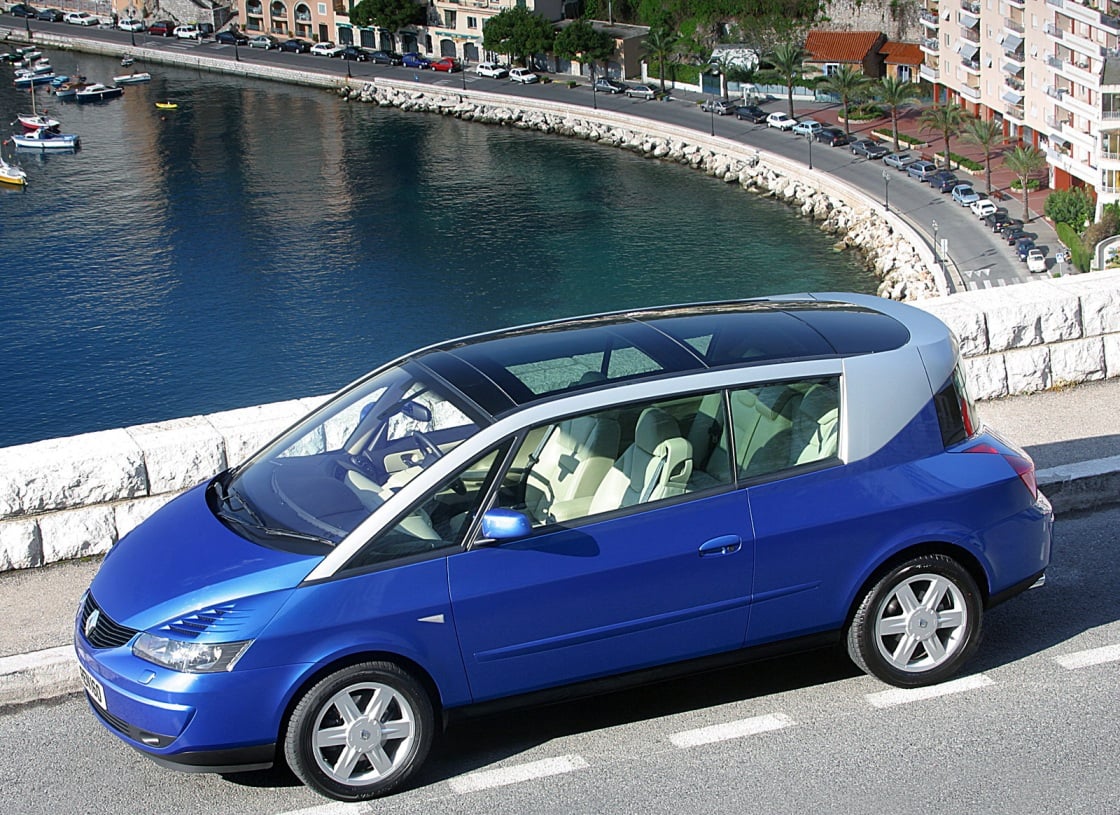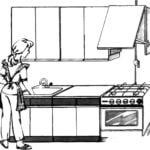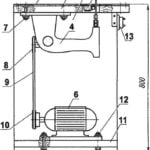 European sales of this vehicle started in September 2001. An incredible price for a fully “packaged” AVANTIME sellers were asking $ 36 000!— not deterred buyers. The car cost them and swear by all that was not only revolutionary shape of the body, was a completely new direction in automotive design, but all the “stuffing” of the new car.
European sales of this vehicle started in September 2001. An incredible price for a fully “packaged” AVANTIME sellers were asking $ 36 000!— not deterred buyers. The car cost them and swear by all that was not only revolutionary shape of the body, was a completely new direction in automotive design, but all the “stuffing” of the new car.
For the first time RENAULT AVANTIME was shown to the public at the Geneva motor show in March 1999. The machine is presented as a conceptual compartment, occupied a Central place on the stand of firm Renault, which gave hope for a speedy mass production of new models.
Created by Renault in collaboration with the French company Matra (in the past it produced sports cars), AVANTIME, according to experts, the most successfully combines high speed and dynamic qualities of the sport coupe with a Seating capacity of minivan and amenities of Executive car.
My first car Louis Renault was collected in 1898 when he was only 21 years old. However, before that Louis Renault had the opportunity to work with a student from león, Serpol, who was involved in the production of steam vehicles and also to become the owner of a small garage in the town of Biancar near Paris.
In his first car, Louis Renault used a single-cylinder De Dion Bouton engine working volume of 0.2 l, but the main feature of this car was rear wheel drive propeller shaft, not chain, as usual for that time.
The machine orders poured in, and soon — 1 October 1898 — Louis with the help of parents and brothers Fernand and Marcel founded the firm Renault Freres (Renault Brothers), which eventually became the largest car company in France.
The car company Renault has quickly gained popularity, and in no small measure contributed to their victory in numerous road races. Suffice it to mention that in 1900 the team’s victory for Renault in the class of voiturettes on the route Paris — Toulouse gave the firm immediately 350 new orders.

RENAULT OH production 1908

Minicar RENAULT 4CV edition 1949

Compact car RENAULT TWINGO (1993)

Minivan RENAULT MEGAN SCENIC — winner of the title “car of the year” (1996)

Front-wheel drive minivan, RENAULT E SPACE — immediate predecessor AVANTIME
New races bring new victories and discoveries of the design, tested in extreme conditions of competitions, migrated on serial cars. So, in 1902 the race on the route Paris -Vienna took part Renault-K with four-cylinder engine producing 24 HP, and the following year the same motors appeared on production machines. A similar fate had hydraulic shock absorbers first tested on race cars Renault.
In 1904 at the Paris motor show the Renault company presented the car where the radiator was located not in front of the engine like most cars, and between the engine and the cabin. The peculiar appearance of these cars with a short and sloping hood until the 30-ies of the last century was the signature style Repair.
In 1905, the company manufactured five models with two – and four-cylinder engines. The greatest success enjoyed the small Renault AG with a two-cylinder engine cylinder capacity of 1.06 liters, and then its modification Renault AG-1 with a more powerful 1.2-liter engine. By the way, many French people now fondly remember about Renault AG-1 that was used in Paris as a taxi.
In September 1914, a column of 1,200 of these machines were delivered to two reserve infantry regiment of the beleaguered German troops of Paris to the front, where the French at the river Marne could hardly contain the onslaught of rushing off to Paris to the Germans. It is possible to prevent the occupation of the French capital. In the history of Paris Renault AG-1 is logged in as “taksi”Marne;.
By the beginning of the First world war the company became one of the leading places in Europe. The war prompted Renault to restructure production and to quickly organize the production of army trucks and light tanks Renault FT-17.
In 1920 the firm mastered the production of cars of new generation of sedan GS with a Renault four-cylinder engine working volume of 2.12 liters and Executive of Renault and Renault FS HD with four and six-cylinder engines and 4,535 7,539 L.
In 1923, the company Renault has released a small triple KJ car with the engine working volume l 0,951, and in 1925 — and quadruple modification of the NN. and quite successfully competed with popular model Citroen 5CV. In the same period produced a car of middle class with a six-cylinder engine capacity of 4,218 L.
The late 20’s — early 30-ies was marked by the production of a series of luxury cars, a typical representative which can be called the Renault Nerva stella with eight-cylinder engine capacity of 7,125 l and closed 5-7-seater bodywork. Modification of this machine, dubbed the Renault Nerva Grand Sport, with a 5.4-liter engine and four-door body aerodynamic shape was considered in his time the most beautiful in France.
In 1938, the firm re-started production of small cars, creating miniature car Renault Juvaquatre with engine capacity of 1,003 l, a monocoque body and independent paduasoy wheels.
During the Second world war Renault was manufacturing military equipment for the Wehrmacht. This was the cause of the raids by U.S. and British bombers into the factories of the company, which were completely destroyed. After the liberation of Paris in late August 1944, Louis Renault was arrested for collaboration with the occupiers. In October of the same year he died, and the firm is nationalized. In its production program was only a little Renault Juvaquatre, which was produced until 1959, right developed in the war the minicar Renault 4CV with zadorspain engine working volume of 0.76 l, very popular among the people who were in the series until 1961.
Since 1951, began production of medium-class sedan of the Renault Fregate with a two-liter overhead valve engine in four years, the sales of the car reached 100, OOO copies. However, at that time the greatest consumer demand was not Executive cars and compact Renault Dauphine with zadorspain 30-strong engine working volume of 0,845 l and its modification Renault Dauphine Gordini with a more powerful (37 HP) engine that, in 1960, sales volume ahead of all other French cars. All in all, until 1968 it was sold about two million of these machines.
A series of compact cars has been continued with the release in 1959 on the basis of the Dauphine sports MAG tyres Renault Floride, and in 1961 the old Renault 4CV took the front-wheel drive Renault R4 with an engine capacity of 0,748 L. a year later, the firm has mastered the rear-engined Renault R8 with a 48-strong engine working volume of 0,956 l, which was the first production car with disc brakes on the front wheels.
Production of Renault 16 1965, a massive car with convertible body and engine, with a displacement of 1.47 liters, made almost entirely of aluminum alloy, became the representative of a new generation of machines, the object of copying for many automotive companies.
In 60-e and 70-e years continued the production of compact cars, among which was a Renault 6 (1969) with the engine working volume 0,845 l compact and practical Renault 5 engines in 0,782 (36 HP) or 0,956 l (47 HP), has gained popularity in almost all European countries.

Van-the RENAULT AVANTIME coupe
The vehicle security system:
The 1.5 front seatbelts with double pretensioners; 2 — side airbag; a 3 — front airbag, 4 — airbag-curtain; 6 — rear seatbelt type Isofix, 7 — rear seat belt with force limiter tension

The design of the body shell RENAULT AVANTIME

Chassis of RENAULT AVANTIME
1 — the caliper brake cylinders of the front wheels; 2 — a brake disk; 3 — McPherson strut; 4 — steering gear; 5 — lower control arm; 6 — a lateral rod rear suspension; 7 — attenuator; 8 — spring rear suspension; 9 — transverse beam rear suspension
Do not forget firm and Executive machinery: in 1975 there was five-door front wheel drive hatchback Renault 30, which became second after Fregate postwar car of the middle class. The machine was equipped with a V-shaped six-cylinder 6,64-liter engine capacity of 131 HP
A year later, came the Renault 14 1.2-liter 57-strong motor, which became a serious competitor to the Volkswagen Golf and the Renault 20 is an economical version of the model “30” with a 90-horsepower engine.
In 80th years the firm has continued to produce new models. In that period, appeared Renault 9, received in 1982 the title of “Car of the year”; Renault 11 with engines of 1.1 and 1.4 liters, which replaced the outdated model of “14”; hatchback Renault 25 with two – and three-liter engines, as well as the increased capacity of the Renault Espase, which became for some years the only European car in this class and the direct predecessor to the hero of our story — the RENAULT AVANTIME introduced a few years. Was prepared by replacing the very popular Renault 5 — his place was taken by Renault Super 5 with a transversely mounted engine. In the late 80-ies in the series launched well-known Renault 19, in 1990 — the same type sedan Renault Chamade, and in 1991 became the “Car of the year” Renault Clio.

The interior cabin is simple and has lots of keys, buttons and levers: the electronic display, the sat-NAV screen-TV — that’s all. The rest of the controls hide behind a hinged panel
Volume small car Renault Twingo, the layout of which is very successfully combined maximum interior volume with minimum dimensions of the car, went on sale in 1993. But the most popular car 90-ies became the Renault Megane offered with several body styles and engines working volume from 1,4 to 2 liters and capacity from 64 to 150 HP
This car was released by Renault in five versions: three – and five-door hatchback, four-door sedan Megan Classic, coupe and five-door wagon with increased capacity Megan Scenic. In 1997 won the honorary title of “Car of the year”.
However, back to “Passing time” — can be translated into Russian language of a name AVANTIME. Car makers assure that this monocab van, coupe and convertible simultaneously.
As you know, sports cars are spacious and will not name, but VANTIME with original body shape with comfort can accommodate four people, furthermore the access to the rear couch is very comfortable: when opening wide (1.4 m!) doors the front seats are moved forward, freeing the passengers pass to the salon. The door is not simply rotated on the hinges due to the rather complex kinematics, and it still moves forward.
The third (rear) door complex shape is a United whole in the trunk lid and aft ends of the body. The trunk is spacious enough, besides it can be turned into a cargo compartment volume of 0.9 m3.
Continuing the theme of comfort of the car lifan, should pay attention to the three keys located on the ceiling of the cabin. Clicking the first shifted and a large transparent skylight. If there is a need to do the ceiling is opaque, then press the second key Luke sudurnesja a black curtain. But the third key is called the Open Air (open air), with it fully slides back the sunroof and at the same time opens all the side Windows. By the way, the body AVANTIME has no center pillar so that key Open Air turns the car into a sort of convertible.
A lot of effort the specialists of Renault, to make driving safe and pleasant. So, the car is equipped with an electronic dashboard, which is located in the center of the front panel; below it is the screen of the Navigator, who, incidentally, can serve as a TV screen. Traditional buttons, keys and knobs on the dashboard is not visible, only three keys on the center console. Also the large drawer, almost the same as the Desk. The glove box is small. The fact that inside it are a CD player and remote audio controls. However, in addition to glove is another box under the Navigator screen.
RENAULT AVANTIME meets all modern standards of active and passive safety of the vehicle. So, the front seats have powerful power structure and built-in seat belts with dual pretensioners. Rear seat belts equipped with force limiters. As for the airbags, the machine is equipped with the front pillows, and side, and appeared not so long ago on modern cars with pillows, curtains that protect the heads of passengers in side impacts.
Base body was a solid steel platform of a minivan Renault Espace. The strut and load-bearing elements of the body — of aluminium alloys, external body parts from composite materials. This structure of the body, the main hub of the car, significantly lower the center of gravity, which had a very favourable effect on the stability of the AVANTIME. Despite the high “minfinovskih” body, high-speed turns, he is confident, without excessive roll.
The suspension with the platform AVANTIME got too Espace (though the springs were shortened by 20 mm reduced clearance), fitted stiffer bushings, new shock absorbers and stabilizer bars. All these innovations significantly improved the behavior of the car on turns.
The machine is equipped with power steering with variable performance: with the rising speed of force on the steering wheel increases just enough to give the driver a confident drive. Even at speeds over 200 km/h AVANTIME is very stable on the highway and great helm.
The power unit RENAULT AVANTIME is a six-cylinder V-engine cylinder capacity of 2,946 liters and power 210 HP paired with a manual six-speed transmission. The developers are also the options of a vehicle from a 165-horsepower turbo engine displacement of 2.0 l and turbo diesel engine of the Espace minivan, and plan to equip AVANTIME automatic adaptive transmission.
New car just starting their journey on the roads of our planet, and only time will tell what will be its popularity among consumers, which in the end will determine his fate. The specialists Renault explained that the investment in preparing the machine for production, amounting to $ 220 million, it will pay off if you manage to sell 90 thousand cars.
Technical characteristics of RENAULT AVANTIME 3.0 V6 24V
Engine…………………………………………………………V6, gasoline
Working volume, l……………………………………………………………..2,946
Compression………………………………………………………………….10,9
Maximum power
at 6000 rpm HP…………………………………………………………210
Drive……………………………………………………….front-wheel
Transmission………………………………………………….mechanical,
6-speed
Front suspension………………………………independent, McPherson
Rear suspension……………………………………………………….dependent
trailing arms with Panhard rod
The front brakes……………………………………………………..disc
ventilated
Rear brakes…………………………………………………………..disk
Tires……………………………………………..225/56 R16 or R17 235/50
Turning circle, m………………………………………………………… 10,9
Trunk volume, m3………………………………………………………….0,53
The volume of the cargo compartment
(with the rear seats folded), M1…………………………………0,9
Curb weight, kg……………………………………………………… 1740
Maximum speed, km/h……………………………………………..220
Acceleration to 100 km/h, ………………………………………………..8,6
Fuel consumption, l/100 km:
urban……………………………………………………………….. 15,9
extra-urban cycle……………………………………………………………….8,9
combined…………………………………………………………….. 11,3
Fuel tank capacity, l……………………………………………………..80
I. EVSTRATOV



